Abstract
Studies using Listeria monocytogenes as an antitumor agent were initiated to determine the requirements for Listeria-mediated tumor inhibition to occur. When Strain 13 guinea pigs were injected with an admixture of viable Listeria and a methylcholanthrene-induced fibrosarcoma in a ratio of 1 bacterium to 100 tumor cells, Listeria had a marked capacity to inhibit tumor growth. This confirms an earlier study in our laboratory (M. M. Dustoor, A. Fulton, W. Croft, and A. A. Blazkovec, Infect. Immun. 23:54-60, 1979). At no time did animals exhibit overt symptoms of disease as a result of Listeria infection. Animals treated with antilymphocyte serum, which had previously been shown to abrogate T-cell functions, were no longer able to suppress Listeria-tumor cell mixtures. Treatment in vivo with carrageenan, a macrophage-inhibitory agent, also abrogated Listeria-mediated tumor inhibition. These results suggest that Listeria-mediated inhibition requires intact T-lymphocyte and macrophage function. Experiments in which Listeria was given in admixture with the tumor cells or in the opposite flank demonstrated that the antitumor effects require intimate association of the Listeria and tumor cells. Histopathological studies, showing that macrophages and lymphocytes are the predominant inflammatory cells present at sites of tumor destruction, further suggest a role for these cells in Listeria-mediated inhibition. Animals which had rejected prior Listeria-tumor cell inocula were resistant to rechallenge with the homologous tumor for more than 1 year. This work thus confirms in vitro studies demonstrating that both lymphocytes and macrophages are required for Listeria-mediated tumor inhibition to occur. This study demonstrates that viable Listeria can have potent antitumor effects without causing overt disease as a result of Listeria infection.
Full text
PDF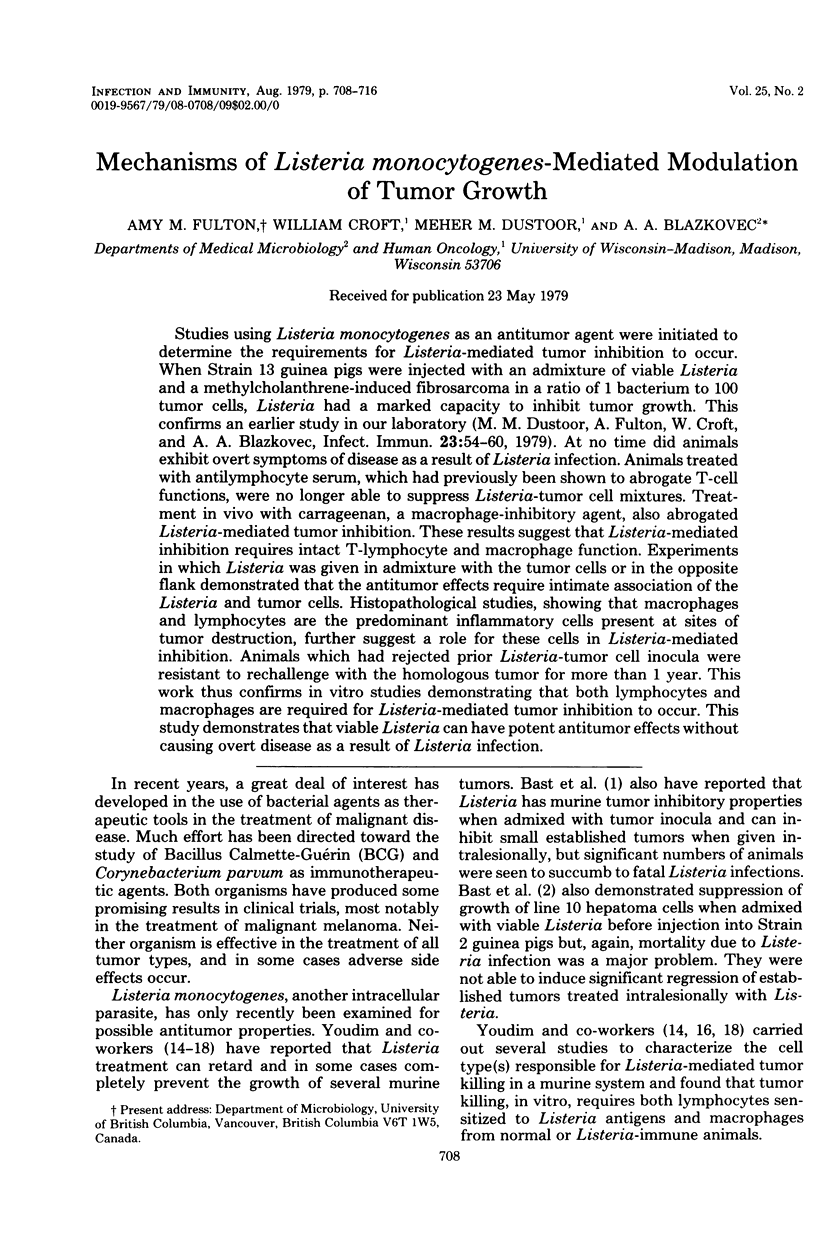


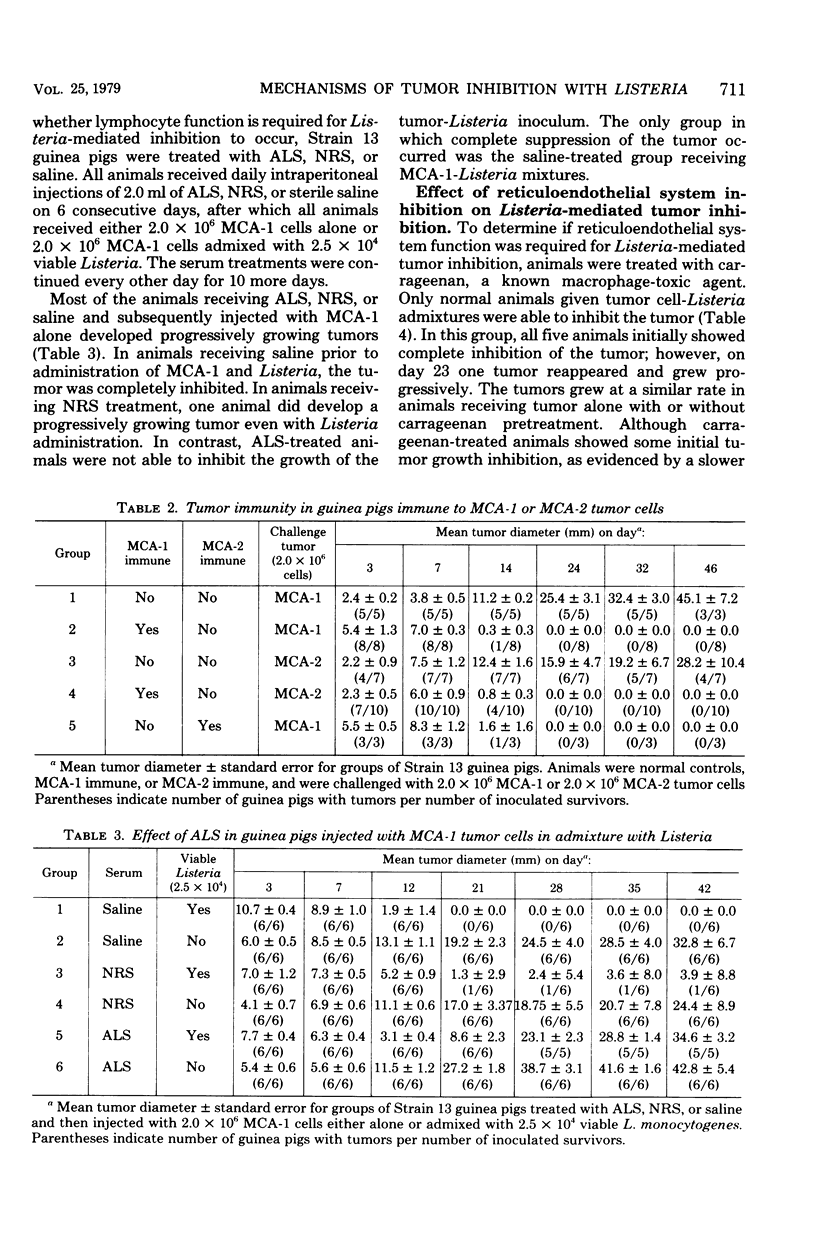
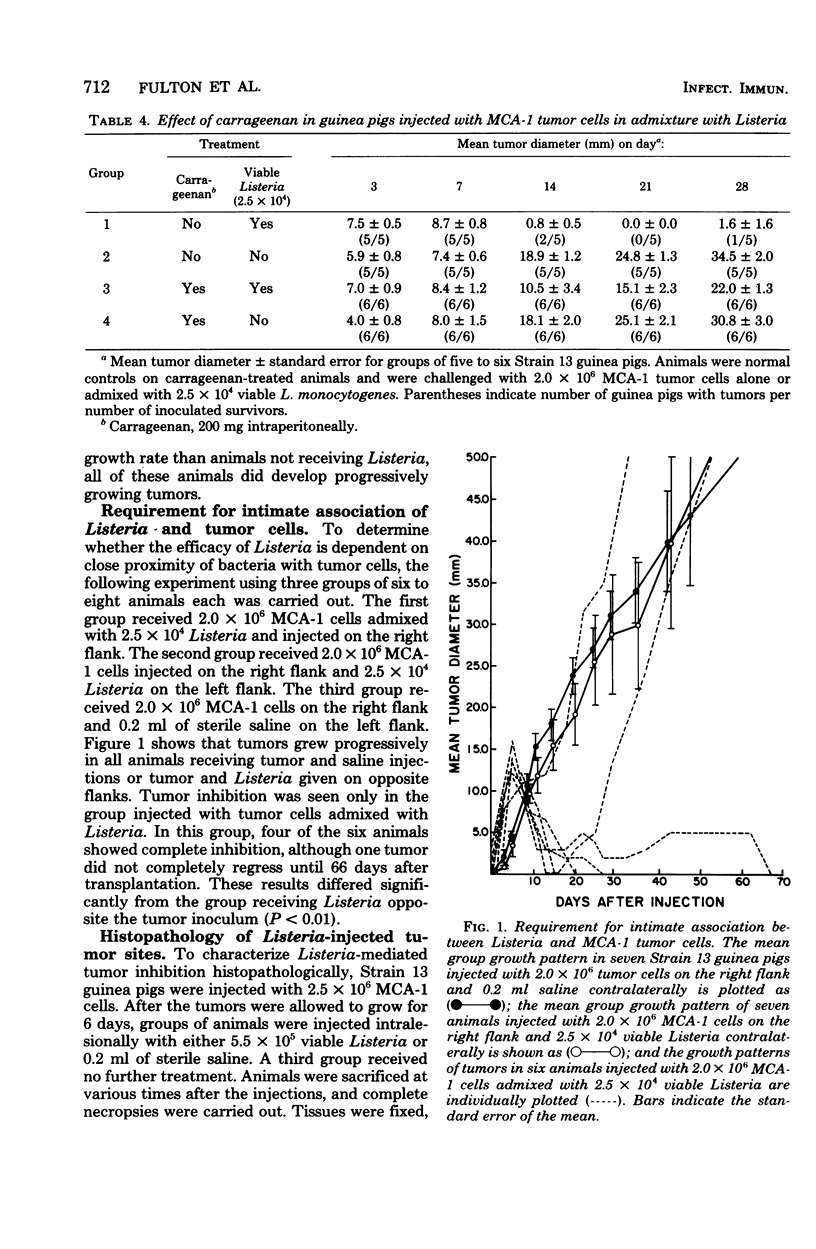

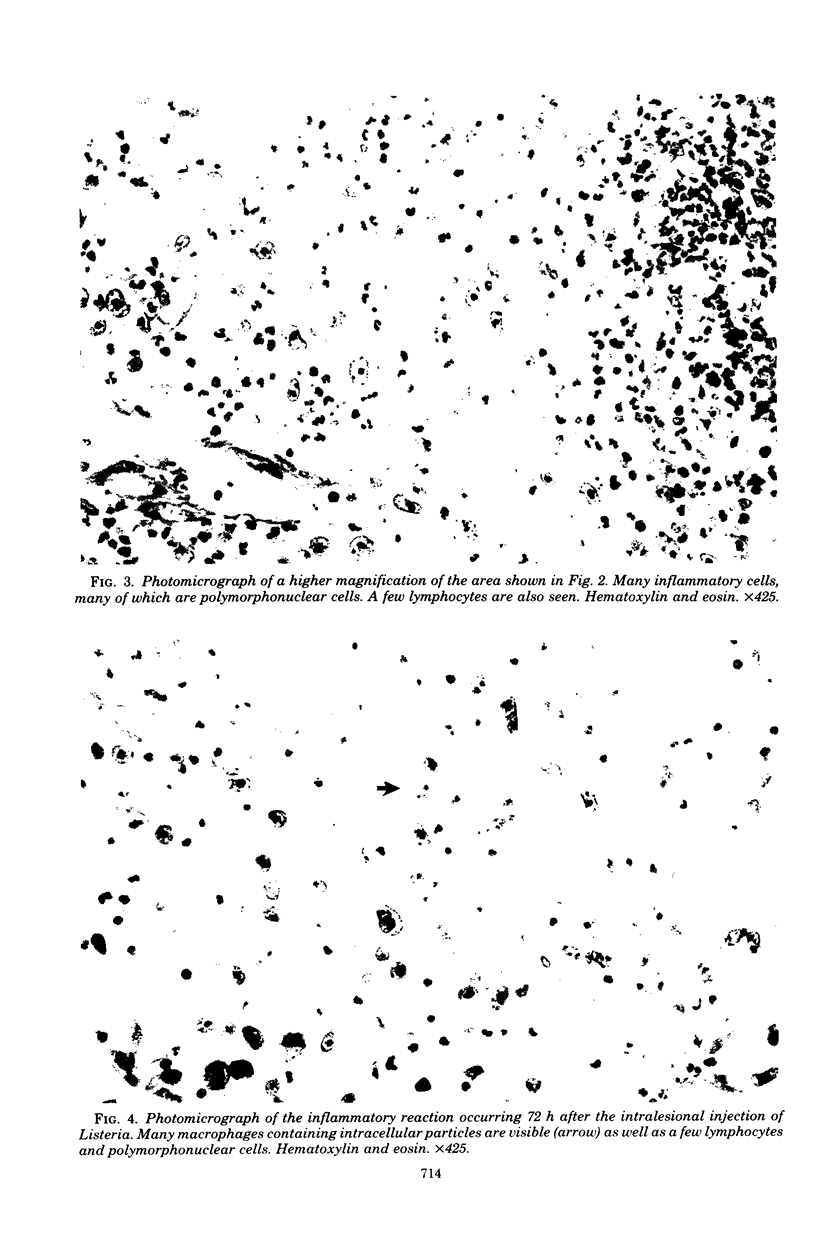
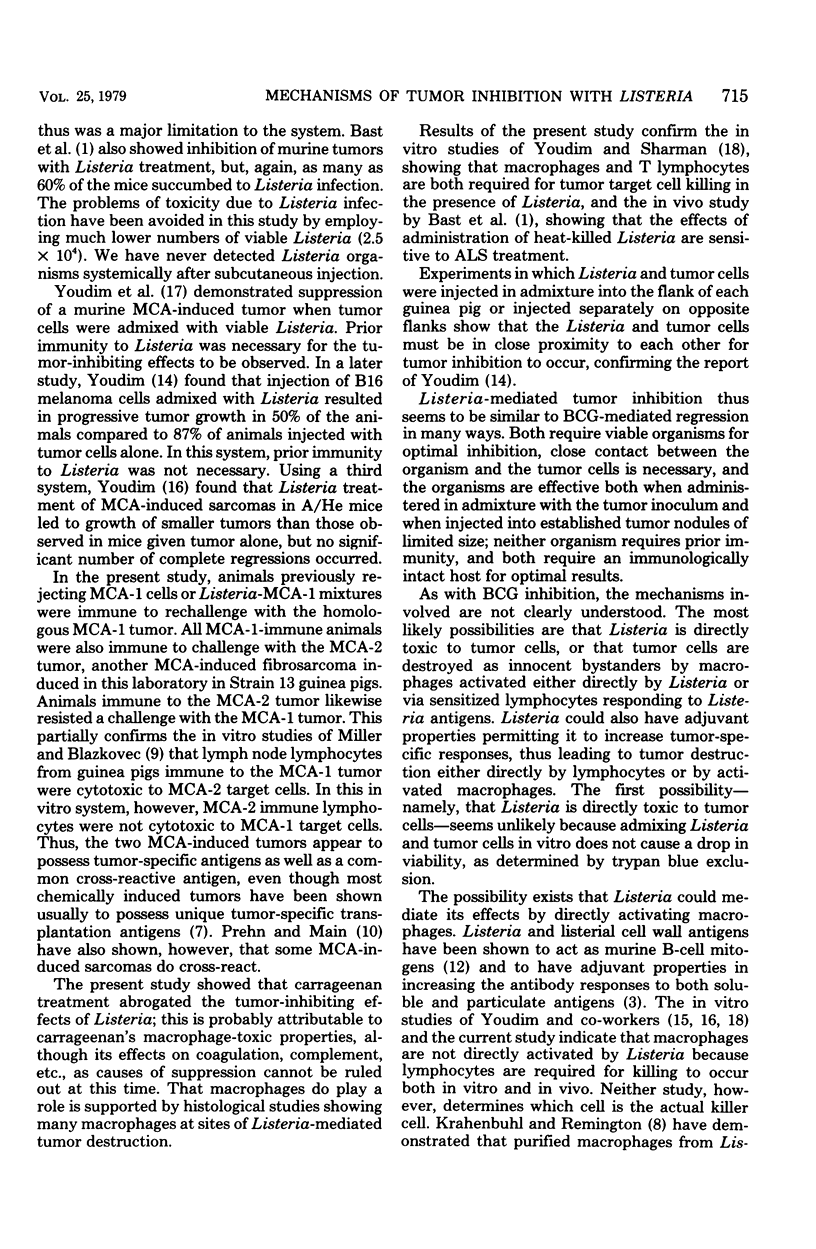

Images in this article
Selected References
These references are in PubMed. This may not be the complete list of references from this article.
- Bast R. C., Jr, Zbar B., Mackaness G. B., Rapp H. J. Antitumor activity of bacterial infection. I. Effect of Listeria monocytogenes on growth of a murine fibrosarcoma. J Natl Cancer Inst. 1975 Mar;54(3):749–756. [PubMed] [Google Scholar]
- Bast R. C., Jr, Zbar B., Miller T. E., Mackaness G. B., Rapp H. J. Antitumor activity of bacterial infection. II. effect of Listeria monocytogenes on growth of a guinea pig hepatoma. J Natl Cancer Inst. 1975 Mar;54(3):757–761. [PubMed] [Google Scholar]
- Cohen J. J., Rodriguez G. E., Kind P. D., Campbell P. A. Listeria cell wall fraction: a B cell mitogen. J Immunol. 1975 Mar;114(3):1132–1134. [PubMed] [Google Scholar]
- Dustoor M. M., Fulton A., Croft W., Blazkovec A. A. Antitumor activity of Listeria monocytogenes on a guinea pig fibrosarcoma. Infect Immun. 1979 Jan;23(1):54–60. doi: 10.1128/iai.23.1.54-60.1979. [DOI] [PMC free article] [PubMed] [Google Scholar]
- Fulton A. M., Dustoor M. M., Kasinski J. E., Blazkovec A. A. Blastogenesis as an in vitro correlate of delayed hypersensitivity in guinea pigs infected with Listeria monocytogenes. Infect Immun. 1975 Sep;12(3):647–655. doi: 10.1128/iai.12.3.647-655.1975. [DOI] [PMC free article] [PubMed] [Google Scholar]
- Halliburton B. L., Blazkovec A. A. Delayed hypersensitivity and acquired cellular resistance in guinea pigs infected with Listeria monocytogenes. Infect Immun. 1975 Jan;11(1):1–7. doi: 10.1128/iai.11.1.1-7.1975. [DOI] [PMC free article] [PubMed] [Google Scholar]
- KLEIN G., SJOGREN H. O., KLEIN E., HELLSTROM K. E. Demonstration of resistance against methylcholanthrene-induced sarcomas in the primary autochthonous host. Cancer Res. 1960 Dec;20:1561–1572. [PubMed] [Google Scholar]
- Krahenbuhl J. L., Remington J. S. The role of activated macrophages in specific and nonspecific cytostasis of tumor cells. J Immunol. 1974 Aug;113(2):507–516. [PubMed] [Google Scholar]
- Miller F. R., Blazkovec A. A. Guinea pig cell-mediated tumor immunity: the chromium release assay detects both cytolysis and serum blocking for syngeneic chemically-induced tumors. Immunol Commun. 1979;8(1):31–47. doi: 10.3109/08820137909044704. [DOI] [PubMed] [Google Scholar]
- PREHN R. T., MAIN J. M. Immunity to methylcholanthrene-induced sarcomas. J Natl Cancer Inst. 1957 Jun;18(6):769–778. [PubMed] [Google Scholar]
- Schuffler C., Campbell P. A. Listeria cell wall fraction. Characterization of in vitro adjuvant activity. Immunology. 1976 Aug;31(2):323–329. [PMC free article] [PubMed] [Google Scholar]
- Youdim Cooperation of immune lymphoid and reticuloendothelial cells during Listeria monocytogenes-mediated tumor immunity. Cancer Res. 1977 Apr;37(4):991–996. [PubMed] [Google Scholar]
- Youdim S. Destruction of experimental malignant melanoma by mediators of cellular immunity. Cancer Res. 1977 Feb;37(2):572–577. [PubMed] [Google Scholar]
- Youdim S., Moser M., Stutman O. Nonspecific suppression of tumor growth by an immune reaction to Listeria monocytogenes. J Natl Cancer Inst. 1974 Jan;52(1):193–198. doi: 10.1093/jnci/52.1.193. [DOI] [PubMed] [Google Scholar]
- Youdim S. Resistance to tumor growth mediated by Listeria monocytogenes. Destruction of experimental malignant melanoma by LM-activated peritoneal and lymphoid cells. J Immunol. 1976 Mar;116(3):579–584. [PubMed] [Google Scholar]
- Youdim S., Sharman M. Resistance to tumor growth mediated by Listeria monocytogenes: collaborative and suppressive macrophage-lymphocyte interactions in vitro. J Immunol. 1976 Nov;117(5 PT2):1860–1865. [PubMed] [Google Scholar]





